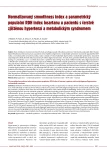Gastroenteropatic neuroendocrine tumors: multidisciplinary approach in therapy
Authors:
S. Kiňová; Ľ. Kekeňák; E. Kováčová; M. Koreň
Authors‘ workplace:
I. interná klinika Lekárskej fakulty UK a UN Bratislava, Slovenská republika, prednostka doc. MU Dr. Soňa Kiňová, PhD.
Published in:
Vnitř Lék 2010; 56(9): 946-950
Category:
60th Birthday - Andrej Dukat MD, Csc., FESC
Overview
Introduction:
Gastroenteropancreatic neuroendocrine tumors (GEP‑ NET) are classified on the basis of hormonal activity of tumor cells to functional and non‑functional tumors. Therapy of well differentiated NETs includes surgical procedures, debulking of tumor mass, biotherapy and peptid receptor radionuclid therapy.
Aim of the study:
Analysis of therapeutic modalities in group of patients with well differentiated GEP‑ NETs.
Results:
In time period from 1. 1. 2005 to 1. 1. 2010 we followed up 50 pts (19 men/ 31 women) with well differentiated GEP neuroendocrine tumors. Primary localisation was: stomach – 6 times, pancreas – 9 times, duodenum – 1 times, jejunum – 4 times, appendix – 3 times, ileum – 23 times, rectum – 4 times. Metastatic disease was affirmed in time of diagnosis in 36 patients. Carcinoid syndroma had 20 pts, 4 pts with pancreatic tumor had functional tumors (2 times overproduction of calcitonine, 1 times of gastrin, 1 times of insuline). Surgical treatment was performed in 40 pts – resection of primary tumor and debulking of metastases, in 5 pts with pancreatic tumor resection was not possible due to invasion to sorrounding tissue and vessels. Biological treatment with long acting somatostatin analogues was indicated in 20 pts with carcinoid syndroma and in 4 pts with functional pancreatic tumors. In 5 pts with non resectable neuroendocrine carcinoma of pancreas peptid radionuclide receptor therapy (PRRT) was indicated: in 4 of them with 90Ytrium‑ DOTA‑ octreotid and in 1 patient with MIBG. In all pts a reduction of tumor volume was noticed. Biotherapy with somatostatin analogues reduced symptoms of hormonal activities and brought on stabilisation of disease in most of patients. In period of follow up 5 patients died.
Conclusion:
Complex therapy in patients with well differentiated neuroendocrine tumors markedly contributes to prolongation of survival of patients and also to enhancement quality of their life.
Key words:
gastroenteropatic neuroendocrine tumor – biological therapy with somatostatin analoge – 5- hydroxyindolacetic acid – chromogranin A
Sources
1. Kulke MH, Mayer RJ. Carcinoid tumors. N Engl J Med 1999; 340: 858– 868.
2. Modlin IM, Lye KD, Kidd M. A 5- decade analysis of 13715 carcinoid tumors. Cancer 2003; 97: 934– 959.
3. Kiňová S, Ďuriš I, Kovácová E et al. Výskyt karcinoidného syndrómu u pacientov s karcinoidom. Vnitř Lék 2004; 50: 131– 137.
4. Falconi M, Plockinger U, Kwekkeboom DJ et al. Well differentiated pancreatic nonfuntioning tumors/ carcinoma. Neuroendocrinology 2006; 84: 196– 211.
5. de Herder WW, Niederle B, Scoazec JY et al. Well differentiated pancreatic tumor/ carcinoma: insulinoma. Neuroendocrinology 2006; 84: 183– 188.
6. Babovic‑ Vuksanovic D, Constantinous CL, Rubin J et al. Familial occurrence of carcinoid tumors and association with other malignant neoplasms. Cancer Epidemiol Biomarkers Prev 1999; 8: 715– 719.
7. Eriksson B, Klöppel G, Krenning E et al. Consensus guidelines for the management of patients with digestive neuroendocrine tumors – well‑differentiated jejunal‑ ileal tumor/ carcinoma. Neuroendocrinology 2008; 87: 8– 19.
8. Connolly HM, Schaff HV, Mullany CJ et al. Carcinoid heart disease: impact of pulmonary valve replacement in right ventricular function and remodeling. Circulation 2002; 106 (12 Suppl 1): I51– I56.
9. Møller JE, Connoly HM, Rubin J et al. Factors associated with progression of carcinoid heart disease. N Engl J Med 2003; 348: 1005– 1015.
10. Falconi M, Bettini R, Scarpa A et al. Surgical strategy in the treatment of gastrointestinal neuroendocrine tumours. Ann Oncol 2001; 12 (Suppl 2): S101– S103.
11. Ramage JK, Goretzki PE, Manfredi R et al. Consensus guidelines for the management of patients with digestive neuroendocrine tumours: well differentiated colon and rectum tumour/ carcinoma. Neuroendocrinology 2008; 87: 31– 39.
12. Louthan O. Neuroendokrinní tumory appendixu. Vnitř Lék 2009; 55: 1051– 1055.
13. Zuetenhorst JM, Bonfrer JM, Korse CM et al. Carcinoid heart disease: the role of urinary 5- hydroxyindoleacetic acid excretion and plasma levels of atrial natriuretic peptide, transforming growth factor‑beta and fibroblast growth factor. Cancer 2003; 97: 1609– 1615.
14. Rindi G, Klöppel G, Couvelard A et al. TNM staging of midgut and hindgut (neuro) endocrine tumors: a consensus proposal including a grading system. Virchows Arch 2007; 451: 757– 762.
15. Ahlman H, Nilsson O, McNicol AM et al. Poorpy differentiated endocrine carcinomas of midgut and hindgut origin. Neuroendocrinology 2008; 87: 40– 46.
Labels
Diabetology Endocrinology Internal medicineArticle was published in
Internal Medicine

2010 Issue 9
Most read in this issue
- Heart and kidneys – a fatal relationship
- Statin myopathy – rarity or reality?
- Our experience with endoscopic drainage of pancreatic pseudocysts
- Adrenal incidentalomas – is the present management rational?
